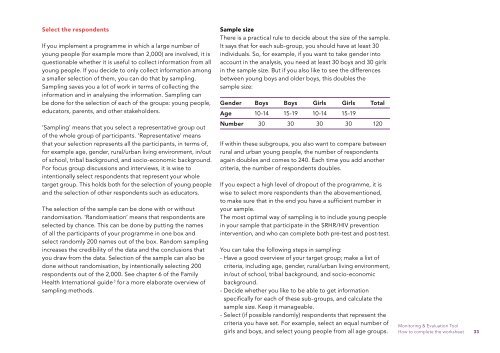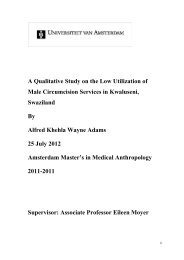ARE YOU ON THE RIGHT TRACK? - Rutgers WPF
ARE YOU ON THE RIGHT TRACK? - Rutgers WPF
ARE YOU ON THE RIGHT TRACK? - Rutgers WPF
- No tags were found...
You also want an ePaper? Increase the reach of your titles
YUMPU automatically turns print PDFs into web optimized ePapers that Google loves.
Select the respondentsIf you implement a programme in which a large number ofyoung people (for example more than 2,000) are involved, it isquestionable whether it is useful to collect information from allyoung people. If you decide to only collect information amonga smaller selection of them, you can do that by sampling.Sampling saves you a lot of work in terms of collecting theinformation and in analysing the information. Sampling canbe done for the selection of each of the groups: young people,educators, parents, and other stakeholders.‘Sampling’ means that you select a representative group outof the whole group of participants. ‘Representative’ meansthat your selection represents all the participants, in terms of,for example age, gender, rural/urban living environment, in/outof school, tribal background, and socio-economic background.For focus group discussions and interviews, it is wise tointentionally select respondents that represent your wholetarget group. This holds both for the selection of young peopleand the selection of other respondents such as educators.The selection of the sample can be done with or withoutrandomisation. ‘Randomisation’ means that respondents areselected by chance. This can be done by putting the namesof all the participants of your programme in one box andselect randomly 200 names out of the box. Random samplingincreases the credibility of the data and the conclusions thatyou draw from the data. Selection of the sample can also bedone without randomisation, by intentionally selecting 200respondents out of the 2,000. See chapter 6 of the FamilyHealth International guide 3 for a more elaborate overview ofsampling methods.Sample sizeThere is a practical rule to decide about the size of the sample.It says that for each sub-group, you should have at least 30individuals. So, for example, if you want to take gender intoaccount in the analysis, you need at least 30 boys and 30 girlsin the sample size. But if you also like to see the differencesbetween young boys and older boys, this doubles thesample size:GenderAgeNumberBoys10-1430Boys15-1930Girls10-1430Girls15-1930Total120If within these subgroups, you also want to compare betweenrural and urban young people, the number of respondentsagain doubles and comes to 240. Each time you add anothercriteria, the number of respondents doubles.If you expect a high level of dropout of the programme, it iswise to select more respondents than the abovementioned,to make sure that in the end you have a sufficient number inyour sample.The most optimal way of sampling is to include young peoplein your sample that participate in the SRHR/HIV preventionintervention, and who can complete both pre-test and post-test.You can take the following steps in sampling:- Have a good overview of your target group; make a list ofcriteria, including age, gender, rural/urban living environment,in/out of school, tribal background, and socio-economicbackground.- Decide whether you like to be able to get informationspecifically for each of these sub-groups, and calculate thesample size. Keep it manageable.- Select (if possible randomly) respondents that represent thecriteria you have set. For example, select an equal number ofgirls and boys, and select young people from all age groups.Monitoring & Evaluation ToolHow to complete the worksheet 33





